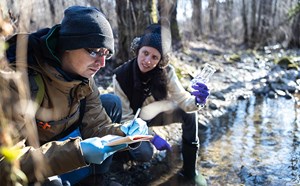
What’s that Rustling in the Grass?
by Patrick Burns MD FAWM DiMM
Secretary / Newsletter Editor, ACEP Wilderness Medicine Section
 Sunset in Namibia (photo credit: Patrick Burns and Dave Young)
Sunset in Namibia (photo credit: Patrick Burns and Dave Young)
As the sun set in a fiery display of yellow and orange, the air cooled mitigating the dangers of the oven-temperature conditions and giving necessary reprieve in the harsh open desert. All of the competitors were finished racing for the day. They were settled into camp - eating dinner, relaxing, laughing and preparing themselves for the next day of the race. This 250 km, 7-day stage race in remote coastal Namibia was grueling and their focus was on optimizing their performance through nutrition and rest. As the medical director of the race, my focus was on their health and safety.
As we relaxed into the evening, there was a sudden rustling in the distance and some loud commotion when a member of the local camp team came to alert us of a puff adder (Bitis arietans) at camp. They had managed to chase it away with a long branch, but they warned us to be vigilant for more of them.
Snakes in Namibia can be deadly. According to the WHO, the puff adder (Bitis arietans) is “thought to be responsible for the majority of serious snake bites throughout Africa.” Though we were prepared for snakes, our local team informed us that the puff adder (Bitis arietans), unlike most snakes that will shy away from interactions with people, may seek out the warm shelters of the tents and are nocturnal. The local team had also seen a “flat adder” nearby that had succumb to the wheel of a 4x4 earlier that day.
It was time for the medical team to problem solve.
Problem 1: What do we do if someone is bitten by a puff adder?
We had come prepared and had thought through this plan prior. We had established relationships with the nearest 2 hospitals and had confirmed, among other things, that they had a supply of polyvalent antivenom on hand to deal with possible envenomation. We had contingency plans in place if there was insufficient supply of antivenom or if a competitor needed evacuation to a larger hospital. Our medical team knew which hospital was closest on every part of the course and how to evacuate a competitor if needed.
Problem 2: What are the effects of a puff adder envenomation?
According to Clinical Toxinology Resources from the University of Adelaide, the puff adder has a 60-80% envenomation rate with potential loss of life or limb. Venom effects include moderate to severe coagulopathy, hemorrhage, tissue necrosis, compartment syndrome, gastrointestinal effects, seizures, cardiotoxicity and shock due to fluid shifts from local tissue destruction. Recommendations are limb immobilization and immediate evacuation to a hospital with polyvalent antivenom.
Problem 3: What do we tell competitors?
With a sighting of a puff adder at camp, there was the possibility it may return and settle into someone’s tent since they are nocturnal. Though we had a medical briefing with competitors at the beginning of the race and every morning, these warnings of snakes was blended in with other health concerns of dehydration, hyponatremia, nutrition, heat stroke, and the importance of hand sanitizer. We felt it was necessary to warn competitors of the danger in order to encourage them to be vigilant but did not want to cause unnecessary fear. We decided to go around to all of the tent and tell them that were was a sighting at camp, but that the snake was chased away. Our instructions to the competitors were:
- Always wear shoes when walking around camp and not to go barefoot.
- Use a flashlight at night to look at the ground in front of you, so as not to inadvertently step on a snake.
- Inspect your tent before you settle in for the night, taking care to look under sleeping bags and in the corners of the tent.
- Remind fellow competitors to do the same.
- Do not try to catch the snake!
Luckily, that was the only living puff adder seen during this ultramarathon and there were no other snakes encountered during the race although Namibia is home to plenty that are fascinatingly dangerous.
Zebra Cobra (Naja nigricintcta nigricincta)
Black Spitting Cobra (Naja nigricincta woodi)
Mozambique Spitting Cobra (Naja mossambica)
Black-necked Spitting Cobra (Naja nigricollis)
Black Mamba (Dendroaspis polylepis)
Cape Copra (Naja nivea)
Anchieta’s Cobra (Naja anchietae)
Bibron’s Stiletto Snake (Atractapis bibronii)
Many-horned Adder (Bitis cornuta)
Horned Adder (Bitis caudalis)
Common Boomslang (Dispholidus typus viridis)
Southern Twig Snake (Thelotornis capensis capensis)
Coral Shield Cobra (Aspidelaps lubricus lubricus)
Speckeled Shield Cobra (Aspidelaps scutatus)
Be sure to check your tents!
Sources:
- https://www-uptodate-com/contents/snakebites-worldwide-clinical-manifestations-and-diagnosis
- http://www.toxinology.com/fusebox.cfm?fuseaction=main.snakes.display&id=SN0200
- https://www.africansnakebiteinstitute.com
- WHO Guidelines for the prevention and clinical management of snakebite in Africa (https://apps.who.int/iris/handle/10665/204458)



